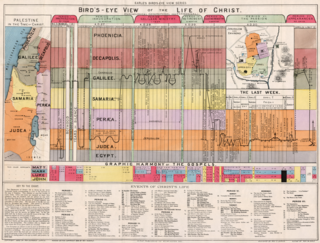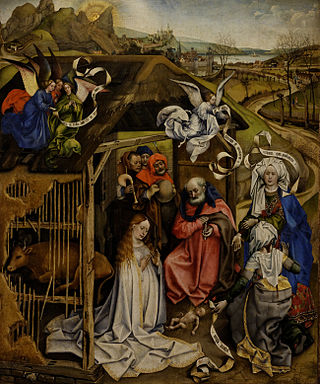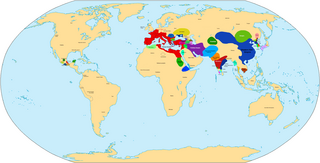Related Research Articles

The 10s decade ran from January 1, AD 10, to December 31, AD 19.

The 20s decade ran from January 1, AD 20, to December 31, AD 29.

The 30s decade ran from January 1, AD 30, to December 31, AD 39.

The 1st century BC, also known as the last century BC and the last century BCE, started on the first day of 100 BC and ended on the last day of 1 BC. The AD/BC notation does not use a year zero; however, astronomical year numbering does use a zero, as well as a minus sign, so "2 BC" is equal to "year –1". 1st century AD follows.
AD 4 was a common year starting on Wednesday or a leap year starting on Tuesday of the Julian calendar and a leap year starting on Tuesday of the Proleptic Julian calendar. In the Roman Empire, it was known as the Year of the Consulship of Catus and Saturninus. The denomination "AD 4" for this year has been used since the early medieval period, when the Anno Domini calendar era became the prevalent method in Europe for naming years.
6 was a common year starting on Friday of the Julian calendar. In the Roman Empire, it was known as the Year of the Consulship of Lepidus and Lucius Arruntius. The denomination "AD 6" for this year has been used since the early medieval period, when the Anno Domini calendar era became the prevalent method in Europe for naming years.
AD 44 (XLIV) was a leap year starting on Wednesday of the Julian calendar. At the time, it was known as the Year of the Consulship of Crispus and Taurus. The denomination AD 44 for this year has been used since the early medieval period, when the Anno Domini calendar era became the prevalent method in Europe for naming years.
The 0s BC were the period between 9 BC and 1 BC, the last nine years of the before Christ era. It is one of two "0-to-9" decade-like timespans that contain nine years, along with the 0s.
This article concerns the period 19 BC – 10 BC.
Year 37 BC was either a common year starting on Monday, Tuesday or Wednesday or a leap year starting on Monday or Tuesday of the Julian calendar and a leap year starting on Monday of the Proleptic Julian calendar. At the time, it was known as the Year of the Consulship of Agrippa and Gallus. The denomination 37 BC for this year has been used since the early medieval period, when the Anno Domini calendar era became the prevalent method in Europe for naming years.

Herod I or Herod the Great was a Roman Jewish client king of the Herodian Kingdom of Judea. He is known for his colossal building projects throughout Judea. Among these works are the rebuilding of the Second Temple in Jerusalem and the expansion of its base—the Western Wall being part of it. Vital details of his life are recorded in the works of the 1st century CE Roman–Jewish historian Josephus.

Herod Antipas was a 1st-century ruler of Galilee and Perea. He bore the title of tetrarch and is referred to as both "Herod the Tetrarch" and "King Herod" in the New Testament, although he never actually held the title of king. He was a son of Herod the Great and a grandson of Antipater the Idumaean. He is widely known today for accounts in the New Testament of his role in events that led to the executions of John the Baptist and Jesus of Nazareth. His father, Herod the Great, was alleged to have ordered the Massacre of the Innocents, marking the earliest Biblical account of the concerns of the government in Jerusalem regarding Jesus's existence.
A calendar era is the period of time elapsed since one epoch of a calendar and, if it exists, before the next one. For example, it is the year 2024 as per the Gregorian calendar, which numbers its years in the Western Christian era.

A chronology of Jesus aims to establish a timeline for the events of the life of Jesus. Scholars have correlated Jewish and Greco-Roman documents and astronomical calendars with the New Testament accounts to estimate dates for the major events in Jesus's life.

Herod Archelaus was the ethnarch of Samaria, Judea, and Idumea, including the cities Caesarea and Jaffa, for nine years. He was the son of Herod the Great and Malthace the Samaritan, brother of Herod Antipas, and half-brother of Herod II. Archelaus came to power after the death of his father Herod the Great in 4 BC, and ruled over one-half of the territorial dominion of his father. Archelaus was removed by the Roman emperor Augustus when Judaea province was formed under direct Roman rule, at the time of the Census of Quirinius.

Judaea was a Roman province from 6 to 132 AD, which incorporated the Levantine regions of Judea, Samaria and Idumea, extending over parts of the former regions of the Hasmonean and Herodian kingdoms of Judea. The name Judaea was derived from the Iron Age Kingdom of Judah.

Publius Sulpicius Quirinius, also translated as Cyrenius, was a Roman aristocrat. After the banishment of the ethnarch Herod Archelaus from the tetrarchy of Judea in AD 6, Quirinius was appointed legate governor of Syria, to which the province of Judaea had been added for the purpose of a census.

The date of the birth of Jesus is not stated in the gospels or in any historical sources and the evidence is too incomplete to allow for consistent dating. However, most biblical scholars and ancient historians believe that his birth date is around 4 to 6 BC. Two main approaches have been used to estimate the year of the birth of Jesus: one based on the accounts in the Gospels of his birth with reference to King Herod's reign, and the other by subtracting his stated age of "about 30 years" when he began preaching.

The 0s began on January 1, AD 1 and ended on December 31, AD 9, covering the first nine years of the Common Era. It is one of two "0-to-9" decade-like timespans that contain nine years, along with the 0s BC.

This article lists historical events that occurred between 1–100 in modern-day Lebanon or regarding its people.
References
- ↑ Bowman, Alan K.; Champlin, Edward; Lintott, Andrew (February 8, 1996). The Cambridge Ancient History. Cambridge University Press. p. 1000. ISBN 978-0-521-26430-3.
- ↑ Evans, Craig A. (2004). Of Scribes and Sages: Ancient versions and traditions. A&C Black. pp. 137–140. ISBN 978-0-567-08083-7.
- ↑ "List of Rulers of Korea". www.metmuseum.org. Retrieved April 21, 2019.
- ↑ Dunn, James D.G. (2003). Jesus Remembered. Wm. B. Eerdmans Publishing. p. 344. ISBN 978-0-8028-3931-2.
- ↑ "Herod | Biography & Facts". Encyclopedia Britannica. Retrieved April 7, 2019.